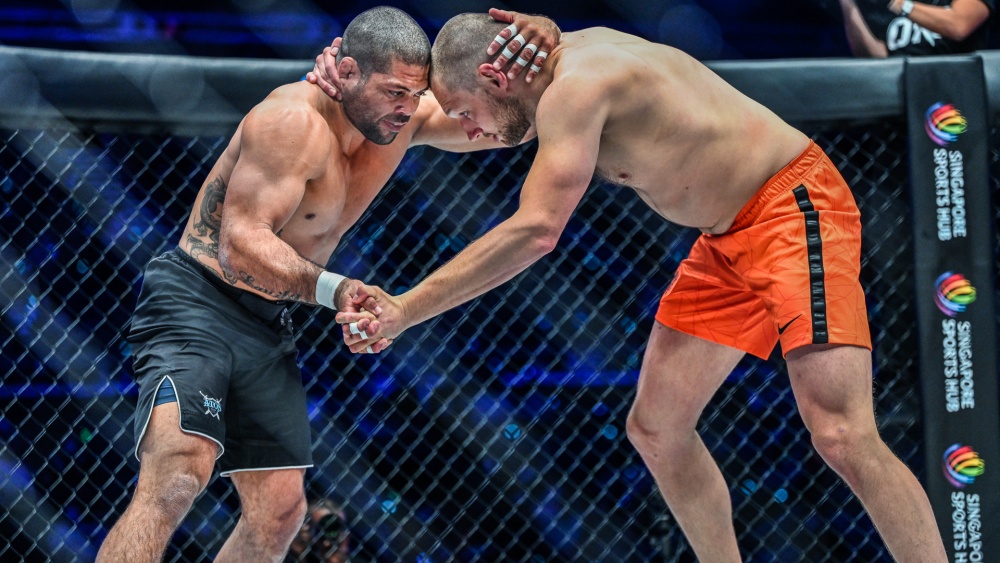Shifting has been an underutilized tool until recently in mixed martial arts. The narrative used to be that shifting left you vulnerable and you would end up only mediocre in both stances. However, that could not be further from the truth. Shifting is when fighters are able to fight out of both an orthodox and southpaw stance. This can include fighters that shift constantly and walk down their opponents, or a situational adjustment to deal with a tricky opponent. Today, Evolve Daily will share how to add shifting to your MMA game.
Pros And Cons
Shifting is a high-level technique that must be practiced tirelessly. It is true that it requires many hours of hard work and practice. The payoff is more than worth it, as few fighters can deal with an opponent skilled at shifting. The only true downside of shifting is the extra work required to learn both stances. However, once learned, shifting has many benefits that outweigh the extra time training.
Shifting stances can open up new lanes of attack and quickly cut those same lanes off for your opponent. Even fighters that fight out of one stance utilize shifting when they rotate and turn their hip over for kicks.
Another benefit of shifting is the increase in movement proficiency. To land a clean shot, your opponent must be able to line their shot up in regards to timing and distance. Fighters can use shifting to constantly change the distance of their head from their opponent, making it near impossible to land cleanly. This also allows the fighter utilising shifting to close distance or counter with an extra layer of defense.
Shifting Punches
https://www.youtube.com/watch?v=4LnjWeATZ5s
To explore the nuances of shifting with your punches, look towards the boxing greats of old. Although modern boxers, such as Vasyl Lomachenko, Oleksandr Usyk, and Tyson Fury utilize shifting, the technique was much more common in the champions of old school boxing. Marvelous Marvin Hagler was one such champion, often catching his opponents off guard by switching stances mid combination.
Interestingly, Hagler switched by allowing his opponent to move, instead of adjusting his position to his opponent. He frequently used this concept after hitting his opponent with a gazelle jab, leaping past them. Instead of resetting to his southpaw stance, Marvelous Marvin would simply punch out of the orthodox stance that he landed in, allowing for quick follow-ups against an opponent that was turning into his shot.
https://www.youtube.com/watch?v=Le2_kV0HW9c
The legendary Roberto Duran was a master of using shifts to gain the upper hand on the inside and to close distance. He would often shift into a southpaw stance after throwing a right cross from the outside. This would simultaneously take his head off center line, close distance, and load his left hand for a powerful follow-up.
https://www.youtube.com/watch?v=fIiNVgqfx6w
Manny Pacquiao was another prime example, knocking down Keith Thurman in round one of their fight with a shifting right hook. This shift technique is one of the reasons Manny was able to generate so much power.
https://www.youtube.com/watch?v=9zwUcKzWKxE
Gennady Golovkin often shifts into the opposite stance after throwing his rear hand, allowing him to cut the ring quickly and build on his forward momentum. This also heightened his already legendary power.
Mike Tyson also constantly uses the shift, allowing him to outjab and close distance on much taller opponents. His rapid bobbing and weaving would have him step almost in a walking manner as he closed the gap to his opponent. He even had a signature shift, called the D’mato shift, that let him angle out and load his rear hand for a power shot up the middle of his opponent’s guard.
https://www.youtube.com/watch?v=J6twwyJ5vCc
These shifting techniques are especially useful for a shorter fighter to close distance in mixed martial arts. A beautifully executed example is how Michael Chandler knocked out Dan Hooker with the killing shift technique. He threw a cross to Hooker’s body, shifted forward, and caught Dan Hooker with a left hook from a southpaw stance, winning the fight. The knockout can be seen in the video at 2:33.
Shifting With Kicks
Shifting is an essential skill for anyone looking to maximize their kicking potential. Kicking is essentially an exercise in shifting, as all your weight shifts to your standing leg. Develop this by practicing form in shadow boxing before moving to the heavy bag. This will ensure that you do not use the bag for balance and leverage, compromising your balance if you miss a kick.
Shifting can also be used to set up kicks from advantageous positions. If you and your opponent are both orthodox, you can shift into a southpaw stance to get to an open stance position. In an open stance, the rear kick has a clear pathway. This is the same reason why the right cross is known as a southpaw killer in boxing.
Occupy your opponent’s eyeline with a jab or a cross and step your right leg forward and outside of your opponent’s left leg. This gives you the outside angle in the open stance, one of the most dominant positions in all of mixed martial arts. From here you can blast your opponent with a left head kick, or a left kick to the liver.
Shifting As Defense
Although shifting sets up many offensive opportunities, it is also quite effective as a means of defense. One of the most common techniques in today’s era of MMA is the low kick, often aimed at the calf. A quick step back, or shift, takes your leg completely out of range and will often unbalance an opponent due to their strike missing.
This same shifting technique can quickly remove your leg from danger when your opponent attempts a takedown. Just the threat of you being able to shift will stop many grapplers from dominating you as a striker. Shifting is an important skill, allowing you to not just fight offensively, but also defend against your opponent when needed. Try incorporating some of these shifting techniques and see how it levels up your MMA game!
You may also like:

















